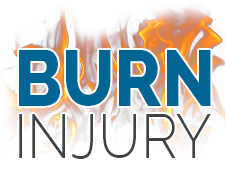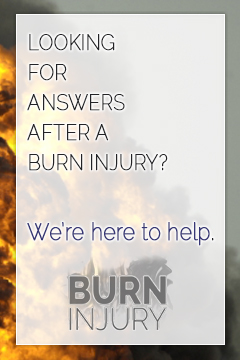Hospitalization
Hospitalization is required for severe burns. In some cases, patients with a second degree burn may require medical treatment in a hospital. For optimal treatment and outcome, patients with third and fourth degree burns should be admitted into a specialized burn center. The hospitalization treatment process for burn injuries will depend on the severity of the burn, including how much of the patient’s total body surface area (TBSA) is affected.
Stabilizing the Patient
When a burn victim first undergoes hospitalization, specialists will immediately work to stabilize the patient. The patient’s airways should be checked to ensure that breathing is not obstructed due to inhalation injury. After burn injuries involving fire, smoke inhalation may cause the airways to become swollen and close up. If inhalation injury occurs, a breathing tube may be passed through the patient’s mouth or nose and into the trachea. Oxygen is then administered through the breathing tube.
Treating Shock
Hospitalization for burns will include prevention and treatment for shock. The patient’s circulation and vital signs will be monitored. Burn patients will be given intravenous (IV) fluids for resuscitation and rehydration. IV fluids help to restore bodily fluids lost through burned skin. A bladder catheter will be used to monitor urine output, which is another indicator of fluid resuscitation.
Debridement
After the burn patient is stabilized, specialists will debride the burn area. Debridement is the process of removing contaminated, infected and dead skin tissue from the affected area. Debridement helps to decrease inflammation, prevent infection, and improve healing in the patient.
There are five methods for debridement:
- Surgical: cutting away burned tissue through surgery
- Autolytic: using the body’s natural enzymes that break down dead tissue
- Enzymatic: using manufactured pharmaceutical enzymes to break down dead tissue
- Mechanical: applying a wet dressing and removing when dry
- Biosurgery: the use of sterile green bottle fly maggots which only consume dead tissue; also called maggot therapy
Burn Management
The burn management process involves a customized healing process for each patient’s unique burn injuries. The burn management process will typically involve wound care such as antibiotics and surgery. Specialists will also address pain management and nutrition during hospitalization.
Wound Care
Dressings will be applied to the burn injury during hospitalization. Dressings are used to protect the wound and aid healing. Dressings may include materials such as gauze and fabric, as well as substances such as gels and creams. Antibiotics are typically administered by mouth, intravenously, or topically. Topical antibiotics may include creams or ointments applied to the burn area. Patients may require skin graft surgery, which involves transplanting tissue from an unburned area to the burned area.
Pain Management
A number of pain treatments may be used to help relieve the severe pain associated with burn injuries. Simple analgesics such as acetaminophen and ibuprofen may be used. For severe pain, opioids such as morphine may be administered. Itching may be aided with antihistamines, nerve stimulation techniques, or massage. Patients with high anxiety may be given benzodiazepines during hospitalization.
Patient Nutrition
Patient nutrition may become an issue during hospitalization, as caloric need of the patient may increase during the healing process. Burn patients are often given nutritional supplements. A high-protein diet to facilitate tissue healing and development.
Sources:
Edwards, J. “Hydrogels and Their Potential Uses in Burn Wound Management.” British Journal of Nursing 19.11 (2010): S12. CINAHL Plus with Full Text. Web. 30 Dec. 2013.
Kim, Leo K P, Hugh C O Martin, and Andrew J A Holland. “Medical Management of Paediatric Burn Injuries: Best Practice.” Journal of Paediatrics and Child Health 48.4 (2012): 290-295. MEDLINE with Full Text. Web. 30 Dec. 2013.
Williams, Catherine. “Assessment and management of paediatric burn injuries.” Nursing Standard 25.25 (2011): 60+. Academic OneFile. Web. 30 Dec. 2013.













